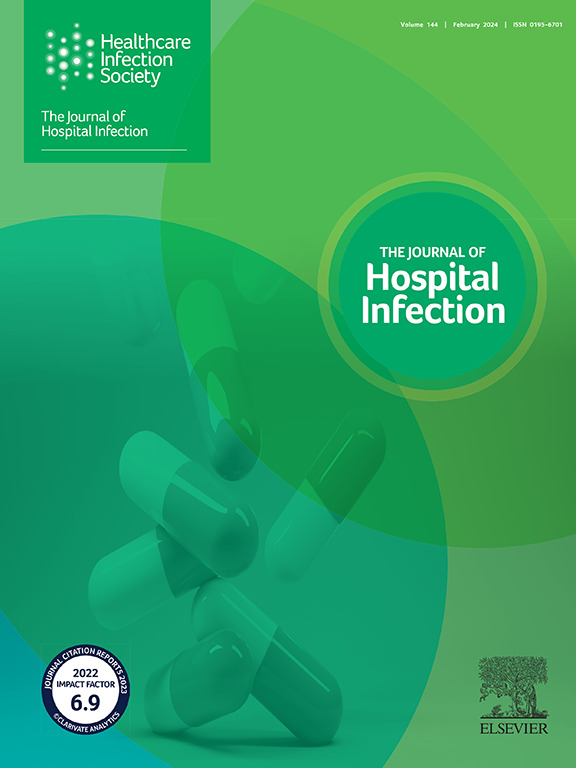探索烧伤重症监护病房感染危险因素和多重耐药菌(MDROs):一项多中心病例对照研究。
IF 3.1
3区 医学
Q1 INFECTIOUS DISEASES
引用次数: 0
摘要
背景:尽管烧伤中心广泛发生MDRO,但缺乏对危重烧伤患者感染风险的研究。本研究旨在确定在烧伤ICU (BICU)住院的危重烧伤患者中与mdro获得相关的危险因素,并确定该人群中mdro的患病率。方法:这是一项多中心观察性病例对照研究,纳入了2015年1月至2022年12月在BICU住院的成年患者(年龄≥18岁)。如果烧伤面积<体表面积(BSA)的10%,在ICU入院24小时内死亡,烧伤时间不详,入院前1年内有MDRO病史或入院前3个月使用抗生素,则排除患者。我们确定了mdro的危险因素和患病率、ICU住院时间(LOS)、医院LOS、30天死亡率和院内死亡率作为研究结果。采用1:1比例的精确匹配方法,根据年龄、性别、入学年份进行分组匹配。在适当的情况下,采用逐步前向选择、逻辑分析和线性回归分析。结果:共纳入173例患者,仅匹配168例患者:病例组(MDR) 84例患者与对照组(非MDR) 84例患者匹配。患有多药耐药生物体的患者具有较低的格拉斯哥昏迷量表(GCS)基线(未调整OR: 0.88, 95% CI[0.827, 0.944]),较高的基线顺序器官衰竭评估(SOFA)评分(未调整OR: 1.19, 95% CI [1.069, 1.329]), APACHE II评分(未调整OR: 1.11, 95% CI[1.054, 1.161]),入院时有创机械通气(MV)状态(未调整OR: 3.76, 95% CI[1.96, 7.20]),以及较高的受影响体表面积(未调整OR:1.04, 95% CI[1.024, 1.058])与非mdr组比较。然而,回归分析显示,基线GCS较低(OR: 0.904, 95% CI[0.828, 0.987])、TBSA较高(OR: 1.023, 95% CI[1.002, 1.045])和尿路感染(OR: 7.198, 95% CI[1.973, 26.259])的患者更容易发生耐多药感染。MDRO组最常见的分离病原菌为鲍曼不动杆菌(57%),最常见的感染为肺炎(52.4%)。MDR组MV持续时间和ICU LOS(中位数:12 vs. 0天,P=0.0002)和(中位数:28 vs. 17天,P=0.0002)均显著延长。两组在其他结果上无显著差异。结论:我们的研究显示,TBSA烧伤面积较大、GCS较低、SOFA和APACHE II评分较高的烧伤患者MDRO感染风险显著增加。我们的研究结果还需要更多的研究来证实。本文章由计算机程序翻译,如有差异,请以英文原文为准。
Exploring infection risk factors and multi-drug-resistant organisms (MDROs) in burn intensive care units: a multi-centre case–control study
Background
Despite the widespread incidence of multi-drug-resistant organisms (MDROs) within burn centres, there is a lack of research investigating the risk of infection with MDROs in critically ill burn patients. This study aimed to identify the risk factors associated with the acquisition of MDROs among critically ill burn patients admitted to burn intensive care units (BICUs), and to determine the prevalence of MDROs in this population.
Methods
This multi-centre observational case–control study included adult patients (age ≥18 years) admitted to BICUs between January 2015 and December 2022. Patients were excluded if the burn injury affected <10% of the body surface area, they died within 24 h of ICU admission, the timing of the burn injury was unknown, and they had a history of MDRO infection within 1 year prior to admission or antibiotic use 3 months prior to admission. Risk factors for acquiring MDROs, prevalence of MDROs, ICU length of stay (LOS), hospital LOS, 30-day mortality and in-hospital mortality rates were identified as the study outcomes. An exact matching approach with a 1:1 ratio was used to match the two groups based on age, gender and admission year. Stepwise forward selection logistic and linear regression analyses were used when appropriate.
Results
In total, 173 patients were included, of which 168 patients were matched: 84 patients in the case group (MDRO group) and 84 patients in the control group (non-MDRO group). Patients in the MDRO group had lower Glasgow Coma Scale (GCS) baseline scores [unadjusted odds ratio (OR) 0.88, 95% confidence interval (CI) 0.827–0.944], higher baseline Sequential Organ Failure Assessment (SOFA) scores (unadjusted OR 1.19, 95% CI 1.069–1.329), higher APACHE II scores (unadjusted OR 1.11, 95% CI 1.054–1.161), invasive mechanical ventilation (MV) status at admission (unadjusted OR 3.76, 95% CI 1.96–7.20), and a greater proportion of total body surface area (TBSA) affected (unadjusted OR 1.04, 95% CI 1.024–1.058]) compared with the non-MDRO group. However, regression analysis showed that those with lower baseline GCS scores [adjusted OR (aOR) 0.904, 95% CI 0.828–0.987], a greater proportion of TBSA affected (aOR 1.023, 95% CI 1.002–1.045), and urinary tract infections (aOR 7.198, 95% CI 1.973–26.259) were significantly more prone to MDRO infections. The most common isolated pathogen in the MDRO group was Acinetobacter baumannii (57%), and the most common infection was pneumonia (52.4%). The duration of MV and ICU LOS were significantly longer in the MDRO group compared with the non-MDRO group. No significant differences in the other outcomes were observed between the groups.
Conclusion
This study showed a significantly increased risk of MDRO infection in patients who had burns affecting a greater proportion of TBSA, lower GCS scores, and higher SOFA and APACHE II scores. Future studies with larger sample sizes are needed to confirm these results.
求助全文
通过发布文献求助,成功后即可免费获取论文全文。
去求助
来源期刊

Journal of Hospital Infection
医学-传染病学
CiteScore
12.70
自引率
5.80%
发文量
271
审稿时长
19 days
期刊介绍:
The Journal of Hospital Infection is the editorially independent scientific publication of the Healthcare Infection Society. The aim of the Journal is to publish high quality research and information relating to infection prevention and control that is relevant to an international audience.
The Journal welcomes submissions that relate to all aspects of infection prevention and control in healthcare settings. This includes submissions that:
provide new insight into the epidemiology, surveillance, or prevention and control of healthcare-associated infections and antimicrobial resistance in healthcare settings;
provide new insight into cleaning, disinfection and decontamination;
provide new insight into the design of healthcare premises;
describe novel aspects of outbreaks of infection;
throw light on techniques for effective antimicrobial stewardship;
describe novel techniques (laboratory-based or point of care) for the detection of infection or antimicrobial resistance in the healthcare setting, particularly if these can be used to facilitate infection prevention and control;
improve understanding of the motivations of safe healthcare behaviour, or describe techniques for achieving behavioural and cultural change;
improve understanding of the use of IT systems in infection surveillance and prevention and control.
 求助内容:
求助内容: 应助结果提醒方式:
应助结果提醒方式:


